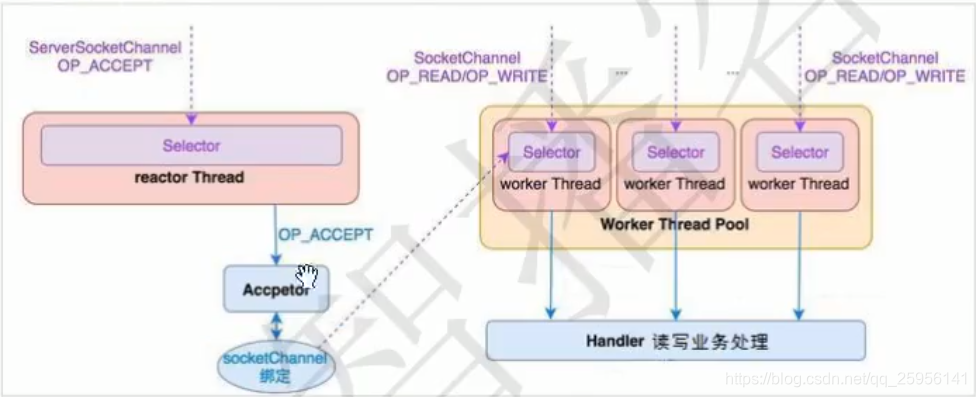介绍
Netty是基于NIO,实现了对NIO的封装。netty常用来做RPC通信,对于传统的NIO而言,API的使用及其不便,在每次读写后都需要flip()操作才能保证整个字节数组的正确读写,因此Netty作者对此实现了封装,他希望netty用户专注于业务代码,而其余部分交给netty来实现。
关于netty入门的代码在我的github上可以下载。
Netty设计
NIO单线程模型

NIO线程池模型

Netty模型

ChannelHandlerContext:

netty的操作的基于Future模型,通过callable实现异步。
有了上述几个模型,基本可以模拟Netty实现对NIO的简单封装,目标是将handler和通信部分分离,如有机会,笔者会在后续的博客中模拟Netty实现对NIO的一个简单封装。
helloworld
netty代码诸如一致,其只需要用户编写自己的handler对业务代码进行处理,其余部分大体相同。
服务端
package netty.helloword;
import io.netty.bootstrap.ServerBootstrap;
import io.netty.channel.ChannelFuture;
import io.netty.channel.ChannelInitializer;
import io.netty.channel.ChannelOption;
import io.netty.channel.EventLoopGroup;
import io.netty.channel.nio.NioEventLoopGroup;
import io.netty.channel.socket.SocketChannel;
import io.netty.channel.socket.nio.NioServerSocketChannel;
public class Server {
public static void main(String[] args) throws InterruptedException {
EventLoopGroup boss = new NioEventLoopGroup();
EventLoopGroup worker = new NioEventLoopGroup();
try{
ServerBootstrap bootstrap = new ServerBootstrap(); //Server配置器
bootstrap.group(boss, worker).channel(NioServerSocketChannel.class)
.option(ChannelOption.SO_BACKLOG, 1024) //设置最多等待建立连接数
.option(ChannelOption.SO_BACKLOG, 32 * 1024) //设置发送缓冲大小
.option(ChannelOption.SO_RCVBUF, 32 * 1024) //设置接收缓冲大小
.childOption(ChannelOption.SO_KEEPALIVE, true) //保持连接
.childHandler(new ChannelInitializer<SocketChannel>() { //增加监听
@Override
protected void initChannel(SocketChannel sc) throws Exception {
sc.pipeline().addLast(new ServerHandler()); //设置业务处理类
}
});
ChannelFuture cf1 = bootstrap.bind(9999).sync(); //bind()异步返回Future通过sync()同步,参考Future模式
cf1.channel().closeFuture().sync(); //为了让程序监听,这里需要保持程序运行,相当于一个死循环
}finally{
boss.shutdownGracefully();
worker.shutdownGracefully();
}
}
}
ServerHandler
package netty.helloword;
import java.io.UnsupportedEncodingException;
import io.netty.buffer.ByteBuf;
import io.netty.buffer.Unpooled;
import io.netty.channel.ChannelHandlerContext;
import io.netty.channel.SimpleChannelInboundHandler;
public class ServerHandler extends SimpleChannelInboundHandler<ByteBuf> {
@Override
protected void channelRead0(ChannelHandlerContext ctx, ByteBuf msg) throws UnsupportedEncodingException{
byte[]req = new byte[msg.readableBytes()];
msg.readBytes(req);
String body = new String(req,"utf-8");
System.out.println("server : " + body);
String response = "Hi Client";
ctx.writeAndFlush(Unpooled.copiedBuffer(response.getBytes())); //会自动释放Buf
}
}
Client
package netty.helloword;
import io.netty.bootstrap.Bootstrap;
import io.netty.channel.ChannelFuture;
import io.netty.channel.ChannelInitializer;
import io.netty.channel.EventLoopGroup;
import io.netty.channel.nio.NioEventLoopGroup;
import io.netty.channel.socket.SocketChannel;
import io.netty.channel.socket.nio.NioSocketChannel;
public class Client {
public static void main(String[] args) {
EventLoopGroup group = new NioEventLoopGroup();
try {
Bootstrap bootstrap = new Bootstrap(); //创建客户端配置器
bootstrap.group(group); //加入到NIO线程池
bootstrap.channel(NioSocketChannel.class);
bootstrap.handler(new ChannelInitializer<SocketChannel>() {
@Override
protected void initChannel(SocketChannel ch) throws Exception {
ch.pipeline().addLast(new ClientHandler());
}
});
ChannelFuture cf = bootstrap.connect("127.0.0.1",9999).sync();//连接
cf.channel().closeFuture().sync();
} catch (InterruptedException e) {
e.printStackTrace();
}finally{
group.shutdownGracefully();
}
}
}
ClientHandler
package netty.helloword;
import io.netty.buffer.ByteBuf;
import io.netty.buffer.Unpooled;
import io.netty.channel.ChannelHandlerContext;
import io.netty.channel.SimpleChannelInboundHandler;
import io.netty.util.CharsetUtil;
import io.netty.util.ReferenceCountUtil;
public class ClientHandler extends SimpleChannelInboundHandler<ByteBuf> {
//收到数据时触发
@Override
protected void channelRead0(ChannelHandlerContext ctx, ByteBuf msg)
throws Exception {
byte buf[] = new byte[msg.readableBytes()];
msg.readBytes(buf);
System.out.println(new String(buf,"utf-8"));
ReferenceCountUtil.release(msg);
}
//通道激活时触发
@Override
public void channelActive(ChannelHandlerContext ctx) throws Exception {
ctx.writeAndFlush(Unpooled.copiedBuffer("hello Server!",CharsetUtil.UTF_8));
}
//异常直接关闭通道
@Override
public void exceptionCaught(ChannelHandlerContext ctx, Throwable cause)
throws Exception {
cause.printStackTrace(); //打印异常
ctx.close();
}
}





















 948
948











 被折叠的 条评论
为什么被折叠?
被折叠的 条评论
为什么被折叠?








